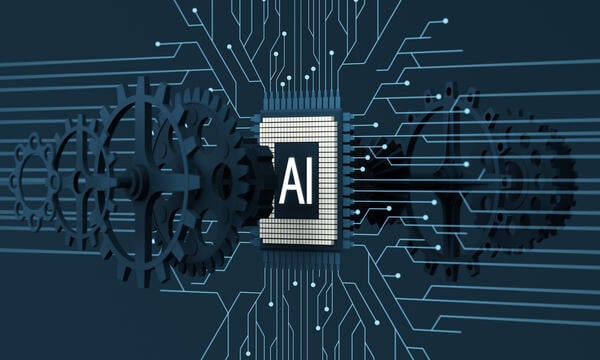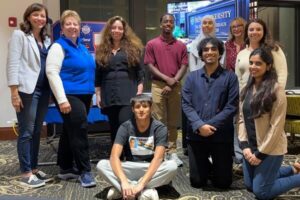
Why Grad Students Can’t Afford to Ignore AI (opinion)
I recently found myself staring at my computer screen, overwhelmed by the sheer pace of AI developments flooding my inbox. Contending with the flow of new tools, updated models and breakthrough announcements felt like trying to drink from a fire hose. As someone who coaches graduate students navigating their academic and professional journeys, I realized I was experiencing the same anxiety many of my students express: How do we keep up with something that’s evolving faster than we can learn?
But here’s what I’ve come to understand through my own experimentation and reflection: The question isn’t whether we can keep up, but whether we can afford not to engage. As graduate students, you’re training to become the critical thinkers, researchers and leaders our world desperately needs. If you step back from advances in AI, you’re not just missing professional opportunities; you’re abdicating your responsibility to help shape how these powerful tools impact society.
The Stakes Are Higher Than You Think
The rapid advancement of artificial intelligence isn’t just a tech trend but a fundamental shift that will reshape every field, from humanities research to scientific discovery. As graduate students, you have a unique opportunity and responsibility. You’re positioned at the intersection of deep subject matter expertise and flexible thinking. You can approach AI tools with both the technical sophistication to use them effectively and the critical perspective to identify their limitations and potential harms.
When I reflect on my own journey with AI tools, I’m reminded of my early days learning to navigate complex organizational systems. Just as I had to develop strategic thinking skills to thrive in bureaucratic environments, we now need to develop AI literacy to thrive in an AI-augmented world. The difference is the timeline: We don’t have years to adapt gradually. We have months, maybe weeks, before these tools become so embedded in professional workflows that not knowing how to use them thoughtfully becomes a significant disadvantage.
My Personal AI Tool Kit: Tools Worth Exploring
Rather than feeling paralyzed by the abundance of options, I’ve taken a systematic approach to exploring AI tools. I chose the tools in my current tool kit not because they’re perfect, but because they represent different ways AI can enhance rather than replace human thinking.
- Large Language Models: Beyond ChatGPT
Yes, ChatGPT was the breakthrough that captured everyone’s attention, but limiting yourself to one LLM is like using only one search engine. I regularly experiment with Claude for its nuanced reasoning capabilities, Gemini for its integration with Google’s ecosystem and DeepSeek for being an open-source model. Each has distinct strengths, and understanding these differences helps me choose the right tool for specific tasks.
The key insight I’ve gained is that these aren’t just fancy search engines or writing assistants. They’re thinking partners that can help you explore ideas, challenge assumptions and approach problems from multiple angles, if you know how to prompt them effectively.
- Executive Function Support: Goblin Tools
One discovery that surprised me was Goblin Tools, an AI-powered suite of tools designed to support executive function. As someone who juggles multiple projects and deadlines and is navigating an invisible disability, I’ve found the task breakdown and time estimation features invaluable. For graduate students managing research, coursework and teaching responsibilities, tools like this can provide scaffolding for the cognitive load that often overwhelms even the most organized among us.
- Research Acceleration: Elicit and Consensus
Perhaps the most transformative tools in my workflow are Elicit and Consensus. These platforms don’t just help you find research papers, but also help you understand research landscapes, identify gaps in literature and synthesize findings across multiple studies.
What excites me most about these tools is how they augment rather than replace critical thinking. They can surface connections you might miss and highlight contradictions in the literature, but you still need the domain expertise to evaluate the quality of sources and the analytical skills to synthesize findings meaningfully.
- Real-Time Research: Perplexity
Another tool that has become indispensable in my research workflow is Perplexity. What sets Perplexity apart is its ability to provide real-time, cited responses by searching the internet and academic sources simultaneously. I’ve found this particularly valuable for staying current with rapidly evolving research areas and for fact-checking information. When I’m exploring a new topic or need to verify recent developments in a field, Perplexity serves as an intelligent research assistant that not only finds relevant information but also helps me understand how different sources relate to each other. The key is using it as a starting point for deeper investigation, not as the final word on any topic.
- Visual Communication: Beautiful.ai, Gamma and Napkin
Presentation and visual communication tools represent another frontier where AI is making significant impact. Beautiful.ai and Gamma can transform rough ideas into polished presentations, while Napkin excels at creating diagrams and visual representations of complex concepts.
I’ve found these tools particularly valuable not just for final presentations, but for thinking through ideas visually during the research process. Sometimes seeing your argument laid out in a diagram reveals logical gaps that weren’t apparent in text form.
- Staying Informed: The Pivot 5 Newsletter
With so much happening so quickly, staying informed without becoming overwhelmed is crucial. I subscribe to the Pivot 5 newsletter, which provides curated insights into AI developments without the breathless hype that characterizes much AI coverage. Finding reliable, thoughtful sources for AI news is as important as learning to use the tools themselves.
Beyond the Chat Bots: Developing Critical AI Literacy
Here’s where I want to challenge you to think more deeply. Most discussions about AI in academia focus on policies about chat bot use in assignments—important, but insufficient. The real opportunity lies in developing what I call critical AI literacy: understanding not just how to use these tools, but when to use them, how to evaluate their outputs and how to maintain your own analytical capabilities.
This means approaching AI tools with the same rigor you’d apply to any research methodology. What are the assumptions built into these systems? What biases might they perpetuate? How do you verify AI-generated insights? These aren’t just philosophical questions; they’re practical skills that will differentiate thoughtful AI users from passive consumers.
A Strategic Approach to AI Engagement
Drawing from the strategic thinking framework I’ve advocated for in the past, here’s how I suggest you approach AI engagement:
- Start with purpose: Before adopting any AI tool, clearly identify what problem you’re trying to solve. Are you looking to accelerate research, improve writing, manage complex projects or enhance presentations? Different tools serve different purposes.
- Experiment systematically: Don’t try to learn everything at once. Choose one or two tools that align with your immediate needs and spend time understanding their capabilities and limitations before moving on to others.
- Maintain critical distance: Use these tools as thinking partners, not thinking replacements. Always maintain the ability to evaluate and verify AI outputs against your own expertise and judgment.
- Share and learn: Engage with peers about your experiences. What works? What doesn’t? What ethical considerations have you encountered? This collective learning is crucial for developing best practices.
The Cost of Standing Still
I want to be clear about what’s at stake. This isn’t about keeping up with the latest tech trends or optimizing productivity, even though those are benefits. It’s about ensuring that the most important conversations about AI’s role in society include the voices of critically trained, ethically minded scholars.
If graduate students, future professors, researchers, policymakers and industry leaders retreat from AI engagement, we leave these powerful tools to be shaped entirely by technologists and venture capitalists. The nuanced understanding of human behavior, ethical frameworks and social systems that you’re developing in your graduate programs is exactly what’s needed to guide AI development responsibly.
The pace of change isn’t slowing down. In fact, it’s accelerating. But that’s precisely why your engagement matters more, not less. The world needs people who can think critically about these tools, who understand both their potential and their perils, and who can help ensure they’re developed and deployed in ways that benefit rather than harm society.
Moving Forward With Intention
As you consider how to engage with AI tools, remember that this isn’t about becoming a tech expert overnight. It’s about maintaining the curiosity and critical thinking that brought you to graduate school in the first place. Start small, experiment thoughtfully and always keep your analytical mind engaged.
The future we’re building with AI won’t be determined by the tools themselves, but by the people who choose to engage with them thoughtfully and critically. As graduate students, you have the opportunity—and, I’d argue, the responsibility—to be part of that conversation.
The question isn’t whether AI will transform your field. It’s whether you’ll help shape that transformation or let it happen to you. The choice, as always, is yours to make.
Source link


